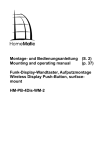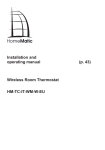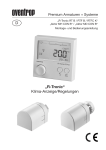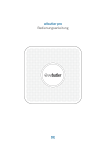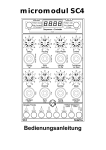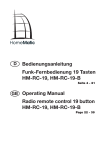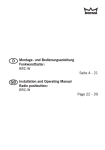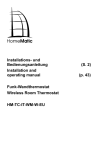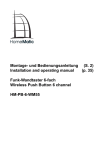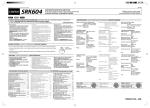Download herunterladen
Transcript
Montage- und Bedienungsanleitung (S. 2) Mounting instruction and operating manual (p. 34) Funk-Wandtaster mit Display 4fach: Radio push-button 4-gang with display wall-mount: HM-PB-4Dis-WM 1. Ausgabe Deutsch 02/2010 Dokumentation © 2009 eQ-3 Ltd., Hong Kong Alle Rechte vorbehalten. Ohne schriftliche Zustimmung des Herausgebers darf dieses Handbuch auch nicht auszugsweise in irgendeiner Form reproduziert werden oder unter Verwendung elektronischer, mechanischer oder chemischer Verfahren vervielfältigt oder verarbeitet werden. Es ist möglich, dass das vorliegende Handbuch noch drucktechnische Mängel oder Druckfehler aufweist. Die Angaben in diesem Handbuch werden jedoch regelmäßig überprüft und Korrekturen in der nächsten Ausgabe vorgenommen. Für Fehler technischer oder drucktechnischer Art und ihre Folgen übernehmen wir keine Haftung. Alle Warenzeichen und Schutzrechte werden anerkannt. Printed in Hong Kong Änderungen im Sinne des technischen Fortschritts können ohne Vorankündigung vorgenommen werden. 90218 / V 1.2 2 Inhaltsverzeichnis 1 2 3 3.1 3.2 3.3 4 4.1 4.2 5 6 7 7.1 7.2 8 8.1 8.2 8.3 8.4 8.5 8.6 8.7 9 10 11 12 13 Hinweise zu dieser Anleitung . . . . . . . . . . . . . . 4 Gefahrenhinweise . . . . . . . . . . . . . . . . . . . . . . . 4 Funktion . . . . . . . . . . . . . . . . . . . . . . . . . . . . . . 5 Allgemeine Funktion . . . . . . . . . . . . . . . . . . . . . 5 Übersicht . . . . . . . . . . . . . . . . . . . . . . . . . . . . . 5 Lieferumfang . . . . . . . . . . . . . . . . . . . . . . . . . . 6 Display, Bedienung, Menü . . . . . . . . . . . . . . . . 7 Display-Aufteilung . . . . . . . . . . . . . . . . . . . . . . 7 Allgemeine Bedienung und Menü . . . . . . . . . . 8 Allgemeine Systeminformation zu HomeMatic . . . . . . . . . . . . . . . . . . . . . . . . 10 Allgemeine Hinweise zum Funkbetrieb . . . . . 11 Montage . . . . . . . . . . . . . . . . . . . . . . . . . . . . . 12 Montage mit Schrauben . . . . . . . . . . . . . . . . 12 Montage mit Klebestreifen . . . . . . . . . . . . . . . 13 Inbetriebnahme . . . . . . . . . . . . . . . . . . . . . . . 15 Batterien einlegen (wechseln) . . . . . . . . . . . . 15 Anlernen . . . . . . . . . . . . . . . . . . . . . . . . . . . . . 16 Namen / Raum ändern . . . . . . . . . . . . . . . . . . 19 Ablernen . . . . . . . . . . . . . . . . . . . . . . . . . . . . . 22 Sprache auswählen . . . . . . . . . . . . . . . . . . . . 24 Werkseinstellungen wieder herstellen . . . . . . 25 Display-Standby Zeit einstellen . . . . . . . . . . . 26 Status Rückmeldung . . . . . . . . . . . . . . . . . . . 28 Geräte-Namen und Schaltfunktionen . . . . . . 28 Funktionen mit Zentrale . . . . . . . . . . . . . . . . . 30 Wartung und Reinigung . . . . . . . . . . . . . . . . . 31 Technische Eigenschaften . . . . . . . . . . . . . . . 31 3 1 Hinweise zu dieser Anleitung Lesen Sie diese Anleitung sorgfältig, bevor Sie ihre HomeMatic Komponenten in Betrieb nehmen. Bewahren Sie die Anleitung zum späteren Nachschlagen auf! Wenn Sie das Gerät anderen Personen zur Nutzung überlassen, übergeben Sie auch diese Bedienungsanleitung. Achtung! Hier wird auf eine Gefahr hingewiesen. Hinweis. Dieser Abschnitt enthält zusätzliche wichtige Informationen! 2 Gefahrenhinweise Betreiben Sie das Gerät nur in Innenräumen und vermeiden Sie den Einfluss von Feuchtigkeit, Staub sowie Sonnen- oder andere Wärmebestrahlung. Jeder andere Einsatz als in dieser Bedienungsanleitung beschrieben ist nicht bestimmungsgemäß und führt zu Garantie- und Haftungsausschluss. Öffnen Sie das Gerät nicht, es enthält keine durch den Anwender zu wartenden Teile. Im Fehlerfall schicken Sie das Gerät an den Service. 4 3 Funktion 3.1 Allgemeine Funktion Wandtaster dienen der Ansteuerung von Empfängern, die an sie angelernt sind. Der Wandtaster verfügt zudem über ein Display, das den Namen sowie den Raum eines angelernten Geräts anzeigt und Statusmeldungen über ausgeführte Funkbefehle ausgibt. Der Wandtaster verfügt über 10 Kanäle, an die jeweils 1 bis 10 Komponenten angelernt werden können. Dadurch lassen sich mehrere Aktionen mit nur einem Tastendruck ausführen. Grundfunktionen und Namen von Aktoren/Räumen können direkt am Wandtaster eingestellt werden. Der Wandtaster ist ein Aufputzgerät, somit lässt er sich nachträglich ganz leicht überall im Haus platzieren. 3.2 Übersicht Der Wandtaster besteht aus zwei Teilen: A 5 B (A) Wandtaster (B) Montageplatte 3.3 Lieferumfang • Wandtaster • Montageplatte • Klebestreifen zur Wandmontage • 3 LR03 Batterien (Micro/AAA) • 2 Holzschrauben 3,0 x 30 mm • 2 Dübel 5 mm 6 4. Display, Bedienung, Menü 4.1 Display-Aufteilung a b c Das Display ist in 3 Bereiche unterteilt: Der mittlere Bereich (b) gibt Informationen über den Aktor und den Raum. Im obigen Beispiel ist für einen Aktor der Name „Licht“ gewählt worden und der Raum wurde als „Wohnzimmer“ bezeichnet. Die Bezeichnungen können individuell angepasst werden (siehe Abschnitt 8.3). Im oberen (a) und unteren (c) Bereich sind die gegebenen Schaltmöglichkeiten dargestellt. Zu einem für Lichtsteuerungen definierten Aktor gehören die Schaltmöglichkeiten „An“ und „Aus“. Bei der AktorAuswahl KeyMatic würden z.B. die Schaltmöglichkeiten „Entriegeln“ und „Verriegeln“ angezeigt (siehe auch Abschnitt 10). 7 Schaltvorgänge werden über das Display bestätigt. Wenn eine Aktion (z.B. Licht einschalten) über den Wandtaster ausgeführt wird, wird dies während des Sendens zuerst mit einer orangen Darstellung des Textes angezeigt. Erhält der Wandtaster die Rückmeldung vom Aktor, dass das Licht erfolgreich eingeschaltet wurde, wird der Text sogleich grün dargestellt. Für den Fall, dass das Licht aus irgendwelchen Gründen nicht eingeschaltet werden konnte, wird dies über einen roten Text angezeigt. 4.2 Allgemeine Bedienung und Menü Die Tastwippe des Wandtasters kann in vier Richtungen gedrückt werden. Generell werden ein kurzer (kürzer als 4 Sekunden) und ein langer Tastendruck (länger als 4 Sekunden) unterschieden. Ein Tastendruck nach links (a) oder rechts (b) lässt einen die verschiedenen angelernten Geräte bzw. Kanäle auswählen. Es können bis zu 10 Kanäle (Position 1 bis 10) belegt werden. Ein Tastendruck nach oben (c) oder unten (d) löst eine Aktion aus. Generell ist oben (c) Einschalten und unten (d) Ausschalten. Ein langer Tastendruck löst bei manchen Aktoren eine zusätzliche Funktion aus. So wird z.B. bei einem Dimmer durch einen langen Tastendruck nach oben oder unten das Licht stufenweise gedimmt. 8 Das Konfigurations-Menü ist durch einen langen Tastendruck links (a) oder rechts (b) zu öffnen. Details zum Konfigurations-Menü entnehmen Sie bitte dem Abschnitt 8. c a b d a b c d Kurzer Tastendruck Geräte-/ Kanalauswahl Geräte-/ Kanalauswahl Schaltvorgang auslösen Schaltvorgang auslösen Langer Tastendruck Menü öffnen Menü öffnen Schaltvorgang auslösen Schaltvorgang auslösen 9 Display-Standby: Das Display geht nach 10 Sekunden in den Ruhezustand, um die Lebensdauer der Batterien zu maximieren. Ein Druck auf eine der vier Seiten der Tastwippe reaktiviert das Display. Nach Reaktivierung wird immer der erste Kanal bzw. Position 1 angezeigt. Die Zeit (Standby) ist wie in Abschnitt 8.7 beschrieben einstellbar. Menü-Time Out: Das Konfigurations-Menü wird über einen langen Tastendruck (länger als 4 Sekunden) geöffnet. Nach 60 Sekunden Inaktivität schließt sich das Menü automatisch und der Wandtaster springt zurück in die Bedienebene. 5. Allgemeine Systeminformation zu HomeMatic Dieses Gerät ist Teil des HomeMatic Haussteuer systems und arbeitet mit dem bidirektionalen BidCoS® Funkprotokoll. Alle Geräte werden mit einer Standardkonfiguration ausgeliefert. Darüber hinaus ist die Funktion des Gerätes über ein Programmiergerät und Software konfigurierbar. Welcher weitergehende Funktionsumfang sich damit ergibt, und welche ergeben, entnehmen Sie bitte dem HomeMatic Systemhandbuch. 10 Alle technischen Dokumente und Updates finden Sie stets aktuell unter www.HomeMatic.com. 6. Allgemeine Hinweise zum Funkbetrieb Die Funk-Übertragung wird auf einem nicht exklusiven Übertragungsweg realisiert weshalb Störungen nicht ausgeschlossen werden können. Weitere Störeinflüsse können hervorgerufen werden durch Schaltvorgänge, Elektromotoren oder defekte Elektrogeräte. Die Reichweite in Gebäuden kann stark von der im Freifeld abweichen. Außer der Sendeleistung und den Empfangseigenschaften der Empfänger spielen Umwelteinflüsse wie Luftfeuchtigkeit neben baulichen Gegebenheiten vor Ort eine wichtige Rolle. Hiermit erklärt die eQ-3 Entwicklung GmbH, dass sich dieses Gerät in Übereinstimmung mit den grundlegenden Anforderungen und den anderen relevanten Vorschriften der Richtlinie 1999/5/EG befindet. Die vollständige Konformitätserklärung finden Sie unter www.HomeMatic.com. 11 7. Montage Der Wandtaster ist ein Aufputz-Gerät und kann somit überall nachträglich im Haus platziert werden. Sie können zwischen zwei verschiedenen Montagearten wählen: (7.1) Montage mit Schrauben, (7.2) Montage mit Klebestreifen 7.1 Montage mit Schrauben Zur Wandmontage gehen Sie wie folgt vor: • Wählen Sie einen geeigneten Montageort aus. • Stellen Sie sicher, dass in der Wand keine Leitungen verlaufen. 52,5 a a a 12 40.0 a • Zuerst sind die vier Bohrlöcher (a) an der Wand zu markieren. Wenn Sie die Montageplatte dazu an die Wand halten, muss die Aufschrift „top“ auf der sichtbaren Seite oben stehen. • Bohren Sie bei einer Steinwand vier Löcher von 5 mm und verwenden Sie die beiliegenden Dübel. Bei einer Holzwand können 1,5 mm zum leichteren Eindrehen der Schrauben vorgebohrt werden. • Drehen Sie die Schrauben ein. • Der Wandtaster ist danach von oben auf die Halterung zu schieben. Wenn Sie den Wandtaster über bereits installierte Taster, Schalter oder Steckdosen anbringen möchten, beachten Sie bitte dringend, dass im Normalfall die Stromleitungen nach oben führen. Es besteht die Gefahr eines elektrischen Schlages. In diesem Fall sollten Sie eine Befestigung mit Klebestreifen wählen. 7.2 Montage mit Klebestreifen Zum Befestigen mit Klebestreifen gehen Sie wie folgt vor: • Wählen Sie einen Ort zur Befestigung aus. • Die Klebestreifen sind auf der Rückseite der 13 Montageplatte zu befestigen (nicht auf der Seite, auf der das Wort „top“ steht). Ziehen Sie dazu auf einer Seite der Klebestreifen den Schutzfilm ab. Die Laschen der Klebestreifen müssen oben in den ausgesparten Bereichen (b) überstehen. b b c • Ziehen Sie die Schutzfolie der zweiten Klebestreifenseite ab. • Nun können Sie die Montageplatte des Wandtasters am gewünschten Ort ankleben. Das Wort „top“ (c) muss im angeklebten Zustand lesbar sein. Drücken Sie die Wandhalterung für einen kurzen Moment fest gegen die Wand. • Der Wandtaster ist danach von oben auf die Halterung aufzuschieben. 14 8. Inbetriebnahme 8.1 Batterien einlegen (wechseln) Der Wandtaster wird mit 3 LR03 (Micro/AAA) Batterien betrieben. • Ziehen Sie den Wandtaster nach oben von der Montageplatte ab. • Auf der Rückseite des Wandtasters sind die Batteriehalterungen zu sehen. • Legen Sie 3 neue LR03-Batterien (Micro/ AAA) polungsrichtig in die Batteriefächer ein. • Falls bereits montiert, ist der Wandtaster danach von oben auf die Montageplatte aufzuschieben. Die Lebensdauer neuer Alkali-Batterien beträgt ca. zwei Jahre. Die Batterielebensdauer ist von der Häufigkeit der Bedienung (bzw. der Display-Aktivierung) abhängig. Wenn die Batterien auszutauschen sind, wird dies im Display signalisiert. Nach Aktivierung des Displays wird eine entsprechende Meldung kurz eingeblendet. Wird das Gerät im Zusammenhang mit einer HomeMatic Zentrale betrieben, wird auch eine ServiceMeldung an die Zentrale geschickt. 15 Vorsicht! Explosionsgefahr bei unsachgemäßem Austausch der Batterien. Normale Batterien dürfen niemals aufgeladen werden. Es besteht Explosionsgefahr. Batterien nicht ins Feuer werfen! Batterien nicht kurzschließen! Verbrauchte Batterien gehören nicht in den Hausmüll! Entsorgen Sie diese in Ihrer örtlichen Batteriesammelstelle! 8.2 Anlernen Damit Funk-Komponenten miteinander kommunizieren können, müssen Sie aneinander angelernt sein. Damit HomeMatic Aktoren mit dem Wandtaster geschaltet werden können, gehen Sie wie folgt vor: • Öffnen Sie das KonfigurationsMenü durch einen langen Tastendruck nach links oder rechts (). • Im Display wird die oberste MenüEbene eingeblendet. Mit einem Tastendruck nach links/rechts () können die verschiedenen Punkte der Menü-Ebene 16 ausgewählt werden. • Wählen Sie den Punkt „Menü, Anlernen“ mit einem Tastendruck nach unten () aus. • In der nächsten Menü-Ebene können Sie mit Tastendrücken nach links/rechts () eine Speicherposition (Kanal) auswählen. Es wird zuerst die nächst freie Position zur Auswahl gestellt. • Bestätigen Sie die Auswahl mit einem Tastendruck nach unten (). Zum Anlernen an eine Zentrale ist der Eintrag „Zentrale“ auszuwählen (Tastendruck ). • Der Anlernvorgang kann nun mit einem Tastendruck nach unten () aktiviert werden. Der Wandtaster sucht dann für 20 Sekunden nach einer anderen HomeMatic Komponente, die ebenfalls im Anlernmodus ist. • Während dieser Zeit ist also auch das anzulernende Gerät in den Anlernmodus zu versetzen. 17 • Nach erfolgreichem Anlernen können Name und Raumbezeichnung geändert werden. • Nach dem Anlernen ist zunächst „Position“ als Name hinterlegt und die zugehörige Nummer als Raum (hier im Beispiel „1“). • Mit Tastendrücken nach links/rechts () können Sie zwischen „Name ändern“ und „Raum ändern“ wechseln. • Bestätigen Sie die Auswahl mit einem Tastendruck nach unten (). Nach der Auswahl kann ein vorgegebener Name oder Raum ausgewählt werden oder Sie definieren diese frei. Für Details lesen Sie bitte Abschnitt 8.3. Der Wandtaster verfügt über 10 Kanäle, im Folgenden auch Positionen genannt. An jeden Kanal können bis zu 10 HomeMatic Geräte angelernt werden. Sind mehrere Geräte an einen Kanal angelernt, wird dies als Gruppe bezeichnet. Ein Schaltvorgang wird für alle Geräte der Gruppe gleichzeitig ausgelöst. 18 8.3 Namen / Raum ändern Für jedes am Wandtaster angelernte Gerät bzw. jeden Kanal kann ein Name (z.B. Licht) und ein Raum (z.B. Wohnzimmer) hinterlegt werden. Sie können aus einer Auswahl vorgegebener Bezeichnungen wählen oder einen individuellen Namen mit maximal 12 Zeichen eingeben. Die Änderung eines Namens oder einer Raumbezeichnung sind gleich und werden daher im Folgenden nur einmal exemplarisch erklärt. • Öffnen Sie das KonfigurationsMenü durch einen langen Tastendruck nach links oder rechts (). • Im Display wird die oberste Menü-Ebene eingeblendet. Mit Tastendrücken nach links/rechts () ist der Punkt „Menü, Kanäle“ auszuwählen. • Mit einem Tastendruck nach unten () kommen Sie in die nächste Menü-Ebene. • In der nächsten Menü-Ebene können Sie mit Tastendrücken nach links/rechts () eine Speicherposition (Kanal) auswählen. Im Beispiel ist es das 19 Gerät mit Namen „Position“ im Raum „1“. • Bestätigen Sie die Auswahl mit einem Tastendruck nach unten (). • Danach stehen Ihnen neben „Ablernen“ die Punkte „Name ändern“ und „Raum ändern“ zur Verfügung. • Wählen Sie () den Punkt „Name ändern“ oder „Raum ändern“ mit einem Tastendruck nach unten () aus. • Im folgenden Beispiel ist der Punkt „Name ändern“ ausgewählt. Das Vorgehen bei der Änderung einer Raum-Bezeichnung ist gleich. • Mit Tastendrücken nach links/ rechts () können Sie die verschiedenen vorgegebenen Bezeichnungen durchgehen. • Mit einem Tastendruck nach unten () wählen Sie einen Namen aus und speichern diesen sogleich. • Im Beispiel rechts wurde die Bezeichnung Licht ausgewählt. 20 • Sie haben zusätzlich die Möglichkeit einen freien Namen zu hinterlegen bzw. einen vorgegebenen zu ändern, dies ist fortfolgend erklärt. Freie Namensvergabe/Editiermodus: • Mit einem langen Tastendruck (länger als 4 Sekunden) nach links oder rechts () wird der Editiermodus gestartet. • Mit Tastendrücken nach links/ rechts () können Sie die 12 Ziffern einzeln anwählen. Mit Tastendrücken nach oben/unten () ändern Sie die jeweilige Ziffer. • Es kann zwischen Groß-/ Kleinschreibung und Sonderzeichen gewechselt werden, drücken Sie dazu den Taster lang nach oben/unten (). • Über einen langen Tastendruck nach links oder rechts () wird der Name gespeichert und der Editiermodus verlassen. • Im nebenstehenden Beispiel wurde neben dem Namen auch die Raumbezeichnung geändert. 21 • Mit dem auf Position/Kanal 1 angelernten Aktor wird somit das Deko-Licht im Wohnzimmer geschaltet. 8.4 Ablernen Am Wandtaster angelernte Geräte können auch wieder abgelernt werden. Das Ablernen erfolgt je Kanal/ Position. Zum Ablernen von Geräten gehen Sie wie folgt vor: • Öffnen Sie das KonfigurationsMenü durch einen langenTastendruck nach links oder rechts (). • Im Display wird die obersteMenüEbene eingeblendet. Mit Tastendrücken nach links/rechts () ist der Punkt „Menü, Kanäle“ auszuwählen. • Mit einem Tastendruck nach unten () kommen Sie in die nächste Menü-Ebene. • In der nächsten Menü-Ebene können Sie mit Tastendrücken nach links/rechts () eine Speicherposition (Kanal) auswählen. Im Beispiel wurde 22 das Gerät „Deko Licht“ im Raum „Wohnzimmer“ ausgewählt. • Bestätigen Sie Ihre Auswahl mit einem Tastendruck nach unten (). • Wählen Sie anschließend mit Tastendrücken nach links/rechts () den Punkt „Ablernen“ aus. • Bestätigen Sie die Auswahl mit einem Tastendruck nach unten (). • Danach erfolgt eine Sicherheitsabfrage. • Das Ablernen (Löschen) muss bestätigt werden. • Mit der Auswahl „Nein“ bzw. einem Tastendruck nach oben () beenden Sie den Ablernvorgang. • Mit „Ja“ bzw. einem langen Tastendruck (länger als 4 Sekunden) nach unten () wird der Ablernvorgang ausgeführt. Wurden mehrere Geräte an einen Kanal bzw. eine Position angelernt, werden diese gemeinsam abgelernt. Andere Kanäle/Positionen bleiben unverändert bestehen. 23 8.5 Sprache auswählen Im Wandtaster sind zur Bedienung und für Menüs die Sprachen Deutsch und Englisch hinterlegt. Zum ändern der Sprache gehen Sie wie folgt vor: • Öffnen Sie das KonfigurationsMenü durch einen langen Tastendruck nach links oder rechts (). • Mit Tastendrücken nach links/ rechts () ist der Punkt „Menü, Einstellung“ auszuwählen. • Mit einem Tastendruck nach unten () gelangen Sie in die nächste Menü-Ebene. • In der nächsten Menü-Ebene ist mit Tastendrücken nach links/ rechts () der Punkt „Sprache“ auszuwählen. • Bestätigen Sie die Auswahl mit einem Tastendruck nach unten (). • Im Punkt Sprache kann nun mit einem Tastendruck nach links/rechts () die Sprache geändert werden. • Die angezeigte Sprache ändert sich gleichzeitig 24 im Display. • Bestätigen Sie Ihre Auswahl mit „Speichern“ bzw. „Save“ (). • Zum Verlassen ohne zu speichern drücken Sie „Zurück“ bzw. „Back“ (). 8.6 Werkseinstellungen wieder herstellen Der Wandtaster kann in den Auslieferungszustand zurückgesetzt werden. Beim Herstellen der Werkseinstellungen gehen alle gespeicherten Einstellungen und Verknüpfungen verloren. Zum Herstellen der Werkseinstellungen gehen Sie wie folgt vor: • Öffnen Sie das Konfigurations-Menü durch einen langen Tastendruck nach links oder rechts (). • Danach ist mit Tastendrücken nach links/rechts () der Punkt „Menü, Einstellung“ auszuwählen. • Mit einem Tastendruck nach unten () gelangen Sie in die nächste Menü-Ebene. • In der nächsten Menü-Ebene ist mit Tastendrücken nach links/rechts () der Punkt „Werkseinst.“ auszuwählen. 25 • Bestätigen Sie die Auswahl mit einem Tastendruck nach unten (). • Das Wiederherstellen der Werkseinstellungen muss bestätigt werden. • Mit der Auswahl „Nein“ bzw. einem Tastendruck nach oben () beenden Sie den Vorgang. • Mit „Ja“ bzw. einem langen Tastendruck (länger als 4 Sekunden) nach unten () werden die Werkseinstellungen wieder hergestellt. Beim Wiederherstellen der Werkseinstellungen gehen alle Verknüpfungen mit angelernten Geräten und vorgenommenen Einstellungen unwiderruflich verloren. 8.7 Display-Standby Zeit einstellen Das Display schaltet sich bei Inaktivität automatisch aus, um die Lebensdauer der Batterien zu erhöhen. Diese Zeit ist auf 10 Sekunden voreingestellt. Diese Einstellung kann in einem Bereich von 1 bis 99 Sekunden eingestellt werden. Zum Ändern der Standby-Zeit gehen Sie wie folgt vor: 26 • Öffnen Sie das KonfigurationsMenü durch einen langen Tastendruck nach links oder rechts (). • Danach ist mit Tastendrücken nach links/rechts () der Punkt „Menü, Einstellung“ auszuwählen. • Mit einem Tastendruck nach unten () gelangen Sie in die nächste Menü-Ebene. • In der nächsten Menü-Ebene ist mit Tastendrücken nach links/ rechts () der Punkt „Standby“ auszuwählen. • Bestätigen Sie die Auswahl mit einem Tastendruck nach unten (). • Die Standby-Zeit kann mit Tastendrücken nach links/rechts () verändert werden. Durch einen langen Tastendruck verstellt sich die Zeit im 10-Sekundentakt. • Mit der Auswahl „Zurück“ bzw. einem Tastendruck nach oben (), beenden Sie den Vorgang ohne zu speichern. • Mit „Speichern“ bzw. einem Tastendruck nach 27 unten () wird die eingestellte Standby-Zeit gespeichert. 9. Status Rückmeldungen Der Wandtaster als HomeMatic-Komponente überträgt Daten mittels BidCoS-Protokoll. Dieses Bidirektionale Protokoll ermöglicht es, dass sendende Geräte eine Rückmeldung vom empfangenden Gerät erhalten. Wird ein Schaltvorgang am Wandtaster durch einen Tastendruck ausgelöst, wird dies im Display durch eine orange Einfärbung der Schrift dargestellt. Nach einer Rückmeldung vom empfangenden Gerät, dass der Schaltvorgang ausgeführt wurde, wird die Schrift grün dargestellt. Wenn der Empfänger den Schaltvorgang nicht ausgeführt hat oder keine Funkverbindung aufgebaut werden konnte, wird dies durch eine rote Schrift angezeigt. 10. Geräte-Namen und Schaltfunktionen Jedem Gerät kann individuell ein Name zugewiesen werden. Mit der Zuweisung eines Namens wird gleichzeitig die Beschriftung für die Schaltfunkti28 onen (Tastendruck oben und unten) festgelegt. Die folgende Tabelle gibt einen Überblick über die zum Namen/Gerät zugehörigen Schaltfunktionen: Gerät Obere Schaltfunktion Untere Schaltfunktion Aktor An Aus Dimmer An Aus Fenster Öffnen Schließen Gruppe An Aus Jalousie Auf Zu KeyMatic Entriegeln Verriegeln Licht An Aus Markise Auf Zu Tür Entriegeln Verriegeln Verschluss Entriegeln Verriegeln WinMatic Öffnen Schließen Bei Dimmern oder z.B. Markisen lassen sich über einen langen Tastendruck Prozentwerte einstellen. So kann ein Dimmer z.B. auf 60% hochgedimmt werden. Diese Werte werden im Display kurzzeitig anstelle des Raumes eingeblendet. 29 11. Funktionen mit Zentrale Im Zusammenspiel mit einer HomeMatic Zentrale sind noch weitere Funktion gegeben, so können z.B. Programme über den Wandtaster gestartet werden. Die Konfiguration muss dann über die Konfigurationsoberfläche der Zentrale geschehen. Über eine Zentrale können alle Namen frei vergeben werden. Zudem könnten einem Tastenpaar auch unterschiedliche Geräte oder Programme zugeordnet werden (z.B. oben „Licht an“, unten „Programm starten“). Dadurch erhöht sich die Anzahl anlernbarer Komponenten auf 200. Das Konfigurations-Menü ist nur noch mit zwei Funktionen belegt: (1) Zentrale: Mit der Funktion „Sync.“ werden die Konfigurationsdaten von einer Zentrale abgefragt. Haben Sie Änderungen an der Konfiguration über die Zentrale vorgenommen, müssen diese durch eine manuelle Betätigung der „Sync.“ Funktion zum Wandtaster übertragen werden. (2) Einstellung, Werkseinstellungen: Die Werkseinstellungen können weiterhin wie unter Abschnitt 8.6 beschrieben hergestellt werden. 30 Nachdem der Wandtaster an eine Zentrale angelernt wurde, können Geräte nicht mehr direkt am Wandtaster ab- oder angelernt werden. Dies muss über die Bedienoberfläche der Zentrale geschehen. 12. Wartung und Reinigung Neben einem Batteriewechsel ist das Produkt ist wartungsfrei. Überlassen Sie eine Reparatur einer Fachkraft. 13. Technische Eigenschaften Display: Freifeldreichweite: Spannungsversorgung: Schutzart: Gehäusefarbe: OLED Vollgrafik-Display bis zu 100 m 3 x LR03 / Micro, AAA IP 20 RAL 9010 Reinweiß mit schwarz umrandeter Sichtscheibe Abmessungen (B x H x T): 83 x 83 x 18 mm Batterielebensdauer: ca. 2 Jahre (bei bis zu 10 Betätigungen je Tag) Maximale Anzahl anlernbarer Geräte: 100 ohne Zentrale 200 mit Zentrale 31 Technische Änderungen, die zur Verbesserung dienen, sind vorbehalten. Entsorgungshinweis Gerät nicht im Hausmüll entsorgen! Elektronische Geräte sind entsprechend der Richtlinie über Elektro- und Elektronik-Altgeräte über die örtlichen Sammelstellen für Elektronik-Altgeräte zu entsorgen. Das CE-Zeichen ist ein Freiverkehrszeichen, das sich ausschließlich an die Behörden wendet und keine Zusicherung von Eigenschaften beinhaltet. 32 1st English edition 02/2010 Documentation © 2009 eQ-3 Ltd., Hong Kong All rights reserved. This manual may not be reproduced in any format, either in whole or in part, nor may it be duplicated or edited by electronic, mechanical or chemical means, without the written consent of the publisher. Typographical and printing errors cannot be excluded. However, the information contained in this manual is reviewed on a regular basis and any necessary corrections will be implemented in the next edition. We accept no liability for technical or typographical errors or the consequences thereof. All trademarks and industrial property rights are acknowledged. Printed in Hong Kong. Changes may be made without prior notice as a result of technical advances. 90218/V 1.2 33 Contents 1 2 3 3.1 3.2 3.3 4 4.1 4.2 5 6 7 7.1 7.2 8 8.1 8.2 8.3 8.4 8.5 8.6 8.7 9 10 11 12 13 34 Information about this manual . . . . . . . . . . . . Hazard information . . . . . . . . . . . . . . . . . . . . . Function . . . . . . . . . . . . . . . . . . . . . . . . . . . . . General function . . . . . . . . . . . . . . . . . . . . . . . Overview . . . . . . . . . . . . . . . . . . . . . . . . . . . . . Scope of supply . . . . . . . . . . . . . . . . . . . . . . . Display, operation, menu . . . . . . . . . . . . . . . . Display areas . . . . . . . . . . . . . . . . . . . . . . . . . General operation and menu . . . . . . . . . . . . . General system information about HomeMatic . . . . . . . . . . . . . . . . . . . . . . General information about radio operation . . Mounting . . . . . . . . . . . . . . . . . . . . . . . . . . . . . Mounting with screws . . . . . . . . . . . . . . . . . . Mounting with adhesive strips . . . . . . . . . . . . Start-up . . . . . . . . . . . . . . . . . . . . . . . . . . . . . . Inserting (replacing) batteries . . . . . . . . . . . . Teaching-in . . . . . . . . . . . . . . . . . . . . . . . . . . . Changing a name/room . . . . . . . . . . . . . . . . . Teaching-out . . . . . . . . . . . . . . . . . . . . . . . . . . Selecting the language . . . . . . . . . . . . . . . . . Restoring the factory settings . . . . . . . . . . . . Setting the display standby time . . . . . . . . . . Feedback statuses . . . . . . . . . . . . . . . . . . . . . Device names and switching functions . . . . Functions with a central control unit . . . . . . . Maintenance and cleaning . . . . . . . . . . . . . . . Technical characteristics . . . . . . . . . . . . . . . . 35 35 36 36 36 37 38 38 39 41 42 43 43 44 46 46 47 50 53 55 56 57 59 59 61 62 63 1 Information about this manual Read this manual carefully before starting to use your HomeMatic components. Keep the manual so you can refer to it at a later date should you need to. If you hand over the device to other persons for use, please hand over the operating manual as well. Attention! This indicates a hazard. Note. This section contains important additional information. 2 Hazard information The device may only be operated indoors and must be protected from the effects of damp and dust, as well as solar or other methods of heat radiation. Using this device for any purpose other than that described in this operating manual does not fall within the scope of intended use and shall invalidate any warranty or liability. Do not open the device: it does not contain any components that need to be serviced by the user. In the event of an error, please return the device to our service department. 35 3 Function 3.1 General function A wall-mounting pushbutton is used to activate the receivers that have been taught-in to it. It also features a display that is used to show the name of a taught-in device and the room where it is located, and to output status messages relating to radio commands that have been issued. The wall-mounting pushbutton has 10 channels; between 1 and 10 components can be taught-in to each of these channels. This means that multiple actions can be performed at just one touch of a single button. Basic functions and the names of actuators/rooms can be set locally on the wall-mounting pushbutton itself. Since this is a surface-mounting device, it can be quite easily retrofitted anywhere in the home. 3.2 Overview The wall-mounting pushbutton consists of two parts: A 36 B (A) Wall-mounting pushbutton (B) Mounting plate 3.3 Scope of supply • Wall-mounting pushbutton • Mounting plate • Adhesive strips for wall mounting • 3x LR03 batteries (micro/AAA) • 2x wood screws 3.0 x 30 mm • 2x plugs 5 mm 37 4. Display, operation, menu 4.1 Display areas a b c The display is divided into 3 areas: The central area (b) provides information about the actuator and the room. In the example above, an actuator has been called “Light” and the room has been named “Living room”. These names can be defined in accordance with individual requirements (refer to Section 8.3). The available switching options are shown in the upper (a) and lower (c) areas. An actuator to be used for controlling lights would have the switching options “On” and “Off” assigned to it. If KeyMatic were to be selected as the actuator, the switching options “Unlock” and “Lock” would be shown instead, for example (refer also to Section 10). 38 Switching operations are confirmed on the display. If an action (such as switching on the light) is performed via the wall-mounting pushbutton, the display text will initially be orange to indicate that the associated command is being transmitted. If the wall-mounting pushbutton receives feedback from the actuator confirming that the light has been switched on successfully, the text will immediately change to green. If the light could not be switched on for any reason, this will be indicated by the text changing to red. 4.2 General operation and menu The rocker on the wall-mounting pushbutton can be pressed in four different directions. A general distinction is also made between pressing and releasing the button (button pressed for under 4 seconds) and pressing and holding down the button (button pressed for more than 4 seconds). Press the left (a) or right (b) of the button to select one of the various taught-in devices or channels. Up to 10 channels (positions 1 to 10) can be assigned. Pressing the button at the top (c) or bottom (d) triggers an action. Usually the top (c) switches a device on and the bottom (d) switches it off. Pressing the button and holding it down can trigger an additional function for some actuators: with a dimmer, for example, pressing the button at the top 39 or bottom and holding it down will dim or brighten the light by degrees. The configuration menu can be opened by pressing the button on the left (a) or right (b) and holding it down. For details on the configuration menu, please refer to Section 8. c a b d a b c d 40 Press button and release Select device/ channel Select device/ channel Trigger switching operation Trigger switching operation Press button and hold down Open menu Open menu Trigger switching operation Trigger switching operation Display standby: The display switches to standby mode after approximately 10 seconds to maximise battery life. Pressing any one of the four sides of the pushbutton rocker will reactivate the display. On reactivation, the first channel or position 1 is displayed by default. The (standby) time is set as described in Section 8.7. Menu time-out: The configuration menu is opened by pressing the button and holding it down (for longer than 4 seconds). After 60 seconds of inactivity the menu closes automatically and the wall-mounting pushbutton returns to operation mode. 5. General information about the HomeMatic system This device is part of the HomeMatic home control system and works with the bi-directional BidCoS® wireless protocol. All devices are delivered in a standard configuration. The functionality of the device can also be configured with a programming device and software. The additional functions that can be made available in this way and the supplementary functions provided by the HomeMatic system when it is combined with other components are described in the HomeMatic System Manual. 41 You can find the latest versions of all technical documents and the latest updates at www.HomeMatic.com. 6. General information about radio operation Radio transmission is performed on a non-exclusive transmission path, which means that there is a possibility of interference occurring. Interference can also be caused by switching operations, electrical motors or defective electrical devices. The range of transmission within buildings can differ greatly from that available in the open air. Besides the transmitting power and the reception characteristics of the receiver, environmental factors such as humidity in the vicinity have an important role to play, as do on-site structural/ screening conditions. eQ-3 Entwicklung GmbH hereby declares that this device complies with the essential requirements and other relevant regulations of Directive 1999/5/EC. You can find the full declaration of conformity at www.HomeMatic.com. 42 7. Mounting The wall-mounting pushbutton is a surfacemounting device, so it can be retrofitted anywhere in the home. You can choose from two different types of mounting: mounting with screws (7.1) or mounting with adhesive strips (7.2). 7.1 Mounting with screws To mount the device on a wall, proceed as follows: • Select a suitable mounting location. • Make sure that no electricity or similar lines run in the wall at this location. 52.5 a a a 40.0 a 43 • First of all, mark four bore hole positions (a) on the wall. When you hold the mounting plate against the wall, the inscription “top” must be visible at the top edge. • If you are working with a stone wall, drill four 5 mm holes and insert the plugs supplied. If you are working with a wooden wall, you can pre-drill 1.5 mm holes to make the screws easier to insert. • Screw the screws in. • Then slide the wall-mounting pushbutton onto the holder from above. If you want to install the wall-mounting pushbutton above other pushbuttons, switches or sockets that are already in place, you must bear in mind the fact that current lines usually run upwards. This means there is a risk of electric shock. In such cases you should attach the wall-mounting pushbutton with adhesive strips. 7.2 Mounting with adhesive strips To attach the wall-mounting pushbutton with adhesive strips, proceed as follows: • Select a mounting location. • Attach the adhesive strips to the rear of the mounting plate (not on the side where the word 44 “top” is printed). To attach the adhesive strips, remove the protective film from one side. The ends of the adhesive strips must protrude from the cut-out areas (b) at the top of the mounting plate. b b • Pull the protective film off the other c side of the adhesive strips. • You can now stick the mounting plate for the wallmounting pushbutton onto the wall at the required site. When the plate is stuck in place, the word “top” (c) must be visible. Briefly press the wall mount firmly against the wall. • Then slide the wall-mounting pushbutton onto the holder from above. 45 8. Start-up 8.1 Inserting (replacing) batteries The wall-mounting pushbutton runs on 3x LR03 (micro/AAA) batteries. • Slide the wall-mounting pushbutton up and off the mounting plate. • You will see the battery holders on the rear of the wall-mounting pushbutton. • Insert 3 new LR03 (micro/AAA) batteries in the battery compartments (making sure that you insert them the right way round). • If you have already attached the mounting plate to the wall, slide the wall-mounting pushbutton onto it from above. The service life of new alkaline batteries is approximately two years. The battery life will depend on how frequently operations are carried out (or how often the display is activated). The display will indicate when it is time to replace the batteries. When the display has been activated, a corresponding message will briefly appear. If the device is being operated in conjunction with a HomeMatic central control unit, a service message is sent to the CCU too. 46 Caution! There is a risk of explosion if the batteries are not replaced correctly. Never recharge standard batteries. Doing so will present a risk of explosion. Do not throw batteries into a fire. Do not short-circuit batteries. sed batteries should not be disposed U of with regular domestic waste. Instead, take them to your local battery disposal point. 8.2 Teaching-in In order to enable communication between radio components, the devices have to be taught-in to one another. If you want to use the wall-mounting pushbutton to switch HomeMatic actuators, proceed as follows: • Open the configuration menu by pressing and holding down the button on the left or right (). • The top menu level appears on the display. Press the button on 47 the left/right () to browse through the different items in that menu level. • Select the “teach-in” item menu by pressing the button at the bottom () . • In the next menu level you can select a storage position (channel) by pressing the button on the left/ right (). The next available position is displayed for selection first. • Confirm your selection by pressing the button at the bottom (). In order to teach in at a central control unit, select the “Central control unit” entry (press button ). • You can now activate the teach-in procedure by pressing the button at the bottom (). For the next 20 seconds the wall-mounting pushbutton will search for another HomeMatic component that is also in teach-in mode. • This means that the device to be taught-in needs to be switched to teach-in mode during this time too. 48 • Once teaching-in has been completed successfully, the device and room names can be changed. • After teaching-in has been completed, “Position” is initially stored as the name and the associated number is stored for the room (in this example, “1”). • Press the button on the left/right () to toggle between “Change name” and “Change room”. • Confirm your selection by pressing the button at the bottom (). Once you have made your selection you can either choose a preset name or room, or define your own. For details on this, please refer to Section 8.3. The wall-mounting pushbutton features 10 channels, also referred to as “positions” in the following. Up to 10 HomeMatic devices can be taught-in to each channel. If several devices have been taught-in to one channel, they are referred to as a group. A switching operation will be triggered for all the devices in the group simultaneously. 49 8.3 Changing a name/room A name (e.g. Light) and a room (e.g. Living room) can be stored for every device taught-in to the wallmounting pushbutton or for every channel. You can choose from a selection of preset names or enter a customised name with a maximum of 12 characters. The name of a device and that of a room are changed in the same way, so just one example is given below to explain both processes. • Open the configuration menu by pressing and holding down the button on the left or right (). • The top menu level appears on the display. Press the button on the left/right () to select the menu item “Channels”. • Press the button at the bottom () to access the next menu level. • In the next menu level you can select a storage position (channel) by pressing the button on the left/ right (). This example refers to the device called “Position” in room “1”. 50 • Confirm your selection by pressing the button at the bottom (). • Now you can select either “Teachout” or the “Change name” or “Change room” items. • Select () the “Change name” or “Change room” item by pressing the button at the bottom () . • In the example below, the “Change name” item has been selected. The procedure for changing the name of a room is the same. • Press the button on the left/right () to browse through the different preset names. • Press the button at the bottom () to select a name and save it at the same time. • In the example on the right, the name “Light” has been selected. • You can also enter and save a customised name or modify a preset name; this process is explained below. 51 Assigning customised names/Edit mode: • Launch edit mode by pressing and holding down the button on the left or right () for more than 4 seconds. • Press the button on the left/ right () to select the 12 digits individually. Press the button at the top/bottom () to change the corresponding digit. • You can toggle between upper/ lower case and special characters by pressing and holding down the pushbutton at the top/bottom (). • Press and hold down the button on the left or right () to save the name and exit edit mode. • In the example on the right, both the device and room names have been changed. • The actuator taught-in to position/channel 1 controls the decorative light in the living room. 52 8.4 Teaching-out Devices that have been taught-in to the wallmounting pushbutton can also be taught-out again. Teaching-out is performed separately for each channel/position. To teach-out devices, proceed as follows: • Open the configuration menu by pressing and holding down the button on the left or right (). • The top menu level appears on the display. Press the button on the left/right () to select the “Channels menu” item. • Press the button at the bottom () to access the next menu level. • In the next menu level you can select a storage position (channel) by pressing the button on the left/ right (). In this example, the “Decorative light” device in room “Living room” has been selected. • Confirm your selection by pressing the button at the bottom (). 53 • Now press the button on the left/right () to select the “Teach-out” item. • Confirm your selection by pressing the button at the bottom (). • A confirmation prompt will then appear. • The teach-out (delete) procedure needs to be confirmed. • Select “No” or press the button at the top () to end the teach-out procedure. • Select “Yes” or press and hold down the button at the bottom () for more than 4 seconds to perform the teach-out procedure. If several devices have been taught-in to one channel or position, they are all taught-out together. Other channels/positions remain unaffected by this teach-out procedure. 54 8.5 Selecting the language The languages English and German are stored in the wall-mounting pushbutton for the purposes of operation and menu display. To change the language, proceed as follows: • Open the configuration menu by pressing and holding down the button on the left or right (). • Press the button on the left/right () to select the menu item “Settings”. • Press the button at the bottom () to access the next menu level. • In the next menu level select the “Language” item by pressing the button on the left/right (). • Confirm your selection by pressing the button at the bottom (). • Under the “Language” menu item you can now change the language by pressing the button on the left/right (). • The display language changes in real time with the language setting. 55 • Confirm your selection by pressing “Save” (). • To exit without saving your changes, press “Back” (). 8.6 Restoring the factory settings The wall-mounting pushbutton can be reset to its initial state. When the factory settings are restored, all saved settings and links are lost. To restore the factory settings, proceed as follows: • Open the configuration menu by pressing and holding down the button on the left or right (). • Then press the button on the left/ right () to select the menu item “Settings”. • Press the button at the bottom () to access the next menu level. • In the next menu level select the “Factory set.” item by pressing the button on the left/right (). 56 • Confirm your selection by pressing the button at the bottom (). • You must confirm that you want to restore the factory settings. • Select “No” or press the button at the top () to end the procedure. • Select “Yes” or press and hold down the button at the bottom () for more than 4 seconds to restore the factory settings. When the factory settings are restored, all links to taught-in devices and all settings you have made are lost and cannot be retrieved. 8.7 Setting the display standby time After a period of inactivity the display switches off automatically in order to maximise battery life. This time period is preset to 10 seconds. This setting can be adjusted within a range from 1 to 99 seconds. To change the standby time, proceed as follows: 57 • Open the configuration menu by pressing and holding down the button on the left or right (). • Then press the button on the left/ right () to select the “Settings menu” item. • Press the button at the bottom () to access the next menu level. • In the next menu level select the “Standby” item by pressing the button on the left/right (). • Confirm your selection by pressing the button at the bottom (). • You can change the standby time by pressing the button on the left/ right (). Press the button and hold it down to change the time in increments of 10 seconds. • Select “Back” or press the button at the top () to end the procedure without saving your changes. • Select “Save” or press the button at the bottom () to save the standby time you have just set. 58 9. Feedback statuses As a HomeMatic component, the wall-mounting pushbutton transmits data via the BidCoS protocol. This bi-directional protocol allows transmitting devices to receive feedback from receiving devices. If the wall-mounting pushbutton is pressed to trigger a switching operation, this is indicated on the display by the text turning orange. Once the receiving device has issued feedback confirming that the switching operation has been performed, the text changes to green. If the receiver has not carried out the switching operation or if no wireless connection could be established, this is indicated by the text turning red. 10. Device names and switching functions A name can be assigned to each individual device. The designations of the switching functions (when the button is pressed at the top or the bottom) are defined when the name is assigned. 59 The table below provides an overview of which switching functions belong to which name/device: Device Top switching function Bottom switching function Actuator On Off Dimmer On Off Window Open Close Group On Off Blinds Open Close KeyMatic Unlock Lock Light On Off Canopy Open Close Door Unlock Lock Lock Unlock Lock WinMatic Open Close For dimmers or canopies, for example, you can set percentage values by pressing the button and holding it down. This means that a dimmer can be made brighter until it reaches 60% of its full brightness, for example. These values appear on the display briefly, in place of the room data. 60 11. Functions with a central control unit Even more functions are available if you use the wall-mounting pushbutton in conjunction with a HomeMatic central control unit, for example you can start programs from the device. In such cases, the configuration settings must be made via the configuration interface of the central control unit. All names can be freely assigned by means of a central control unit. In addition, different devices or programs can be allocated to a pair of buttons (e.g. “Light on” at the top, “Start program” at the bottom). This increases the number of components that can be taught-in to 200. However, the configuration menu still only has two functions assigned to it: (1) Central control unit: The “Sync.” function queries configuration data from a central control unit. If you have made changes to the configuration on the central control unit, you will need to transfer them to the wall-mounting pushbutton by activating the “Sync.” function manually. (2) Settings, factory settings: The factory settings can still be restored as described in Section 8.6. 61 Once the wall-mounting pushbutton has been taught-in to a central control unit, it will no longer be possible to teach devices in to or out from the wall-mounting pushbutton directly. This must be done via the central control unit’s user interface. 12. Maintenance and cleaning Apart from having to replace the batteries, this product is maintenance-free. Enlist the help of an expert to carry out any repairs. 62 13. Technical characteristics Open air range: Display: Up to 100 m OLED fully graphical display Power supply: 3x LR03/micro, AAA Degree of protection: IP 20 Housing colour: RAL 9010 pure white with a window surrounded by a black border Dimensions (W x H x D): 83 x 83 x 18 mm Battery life: Approx. 2 years (at up to 10 operations per day) Maximum number of 100 without a central devices that can control unit be taught-in: 200 with a central control unit We reserve the right to make any technical changes that constitute an improvement to the device. 63 Instructions for disposal Do not dispose of the device with regular domestic waste. Electronic equipment must be disposed of at local collection points for waste electronic equipment in compliance with the Waste Electrical and Electronic Equipment Directive. The CE Marking is simply an official symbol relating to the free movement of a product; it does not warrant a product’s characteristics. eQ-3 AG Maiburger Straße 29 D-26789 Leer www.eQ-3.com 64
































































